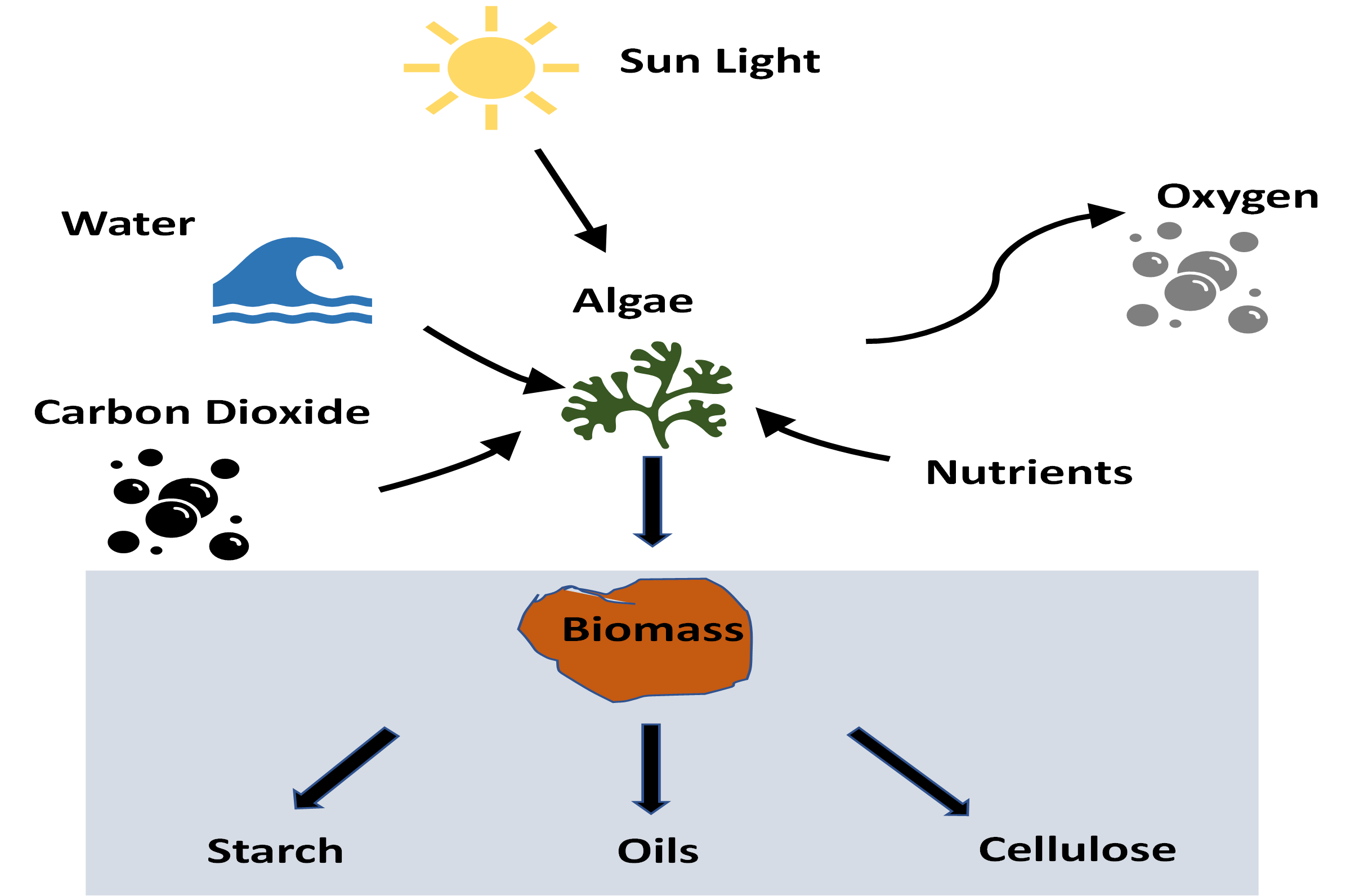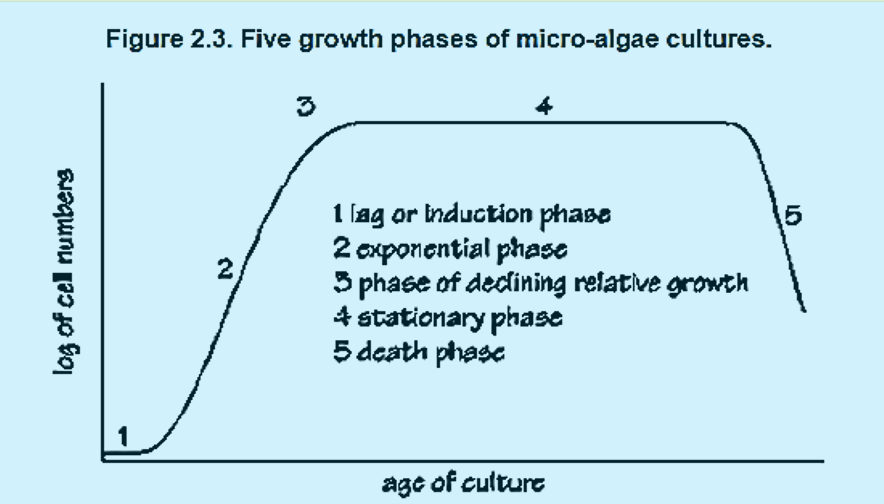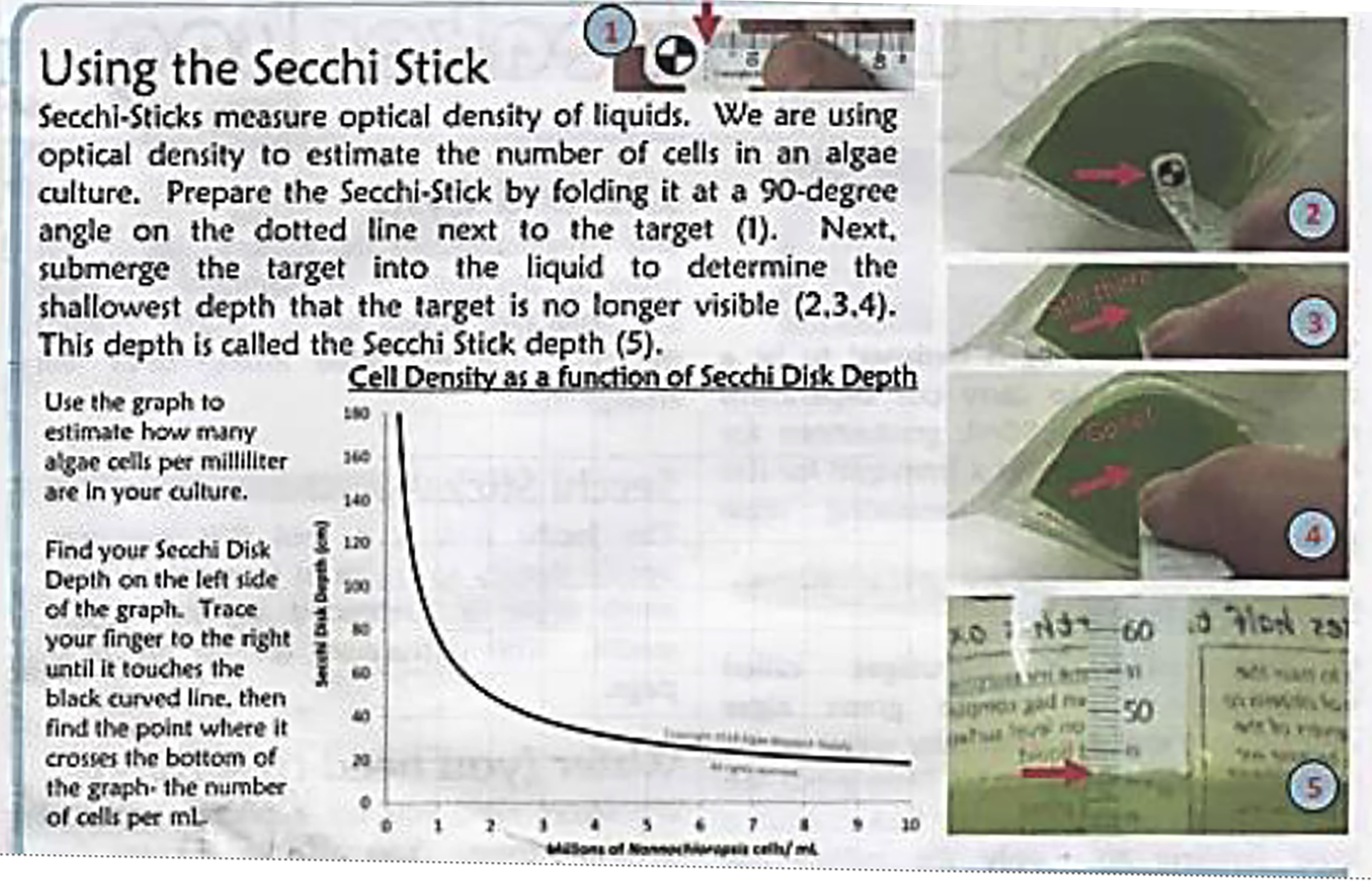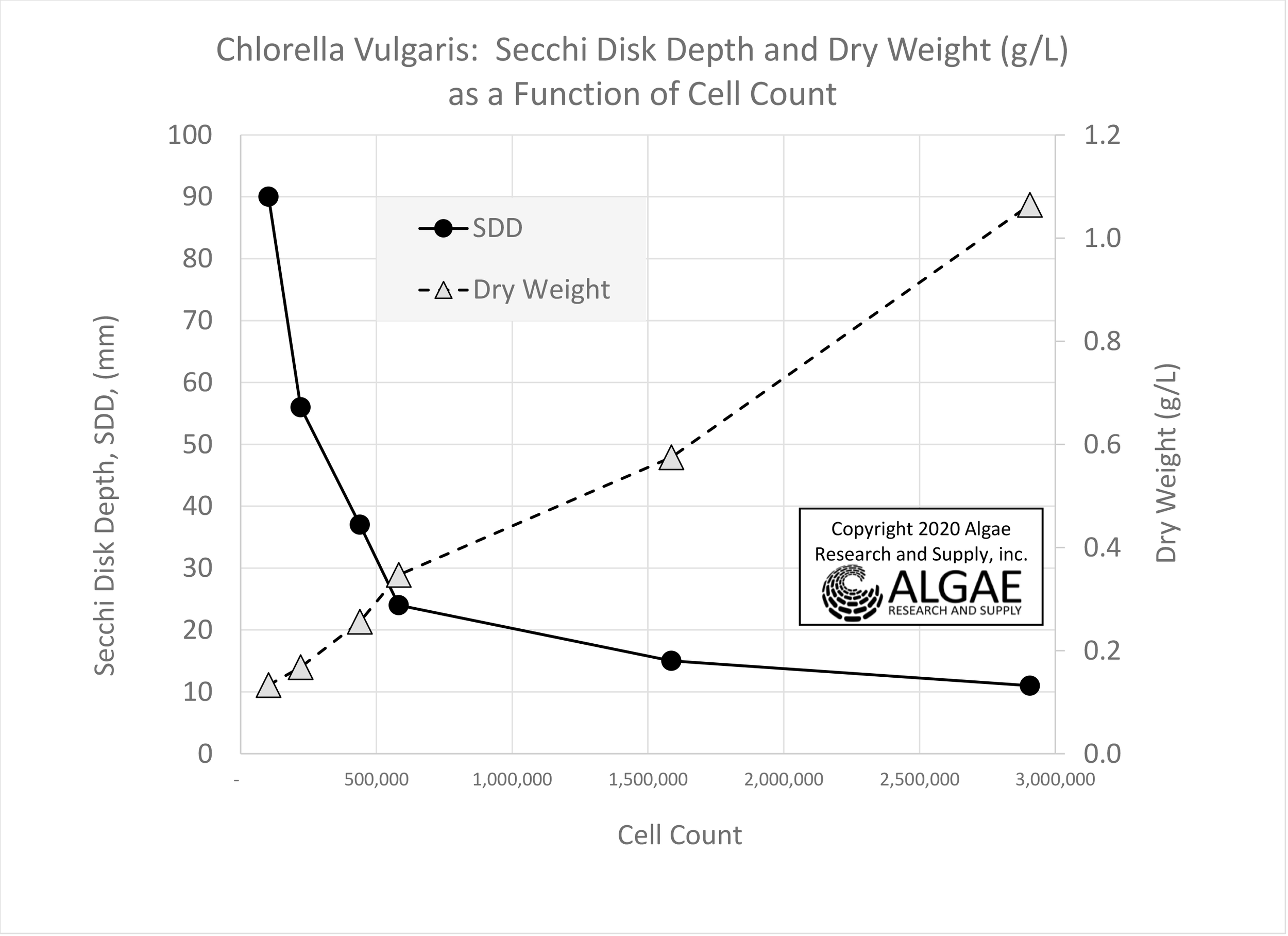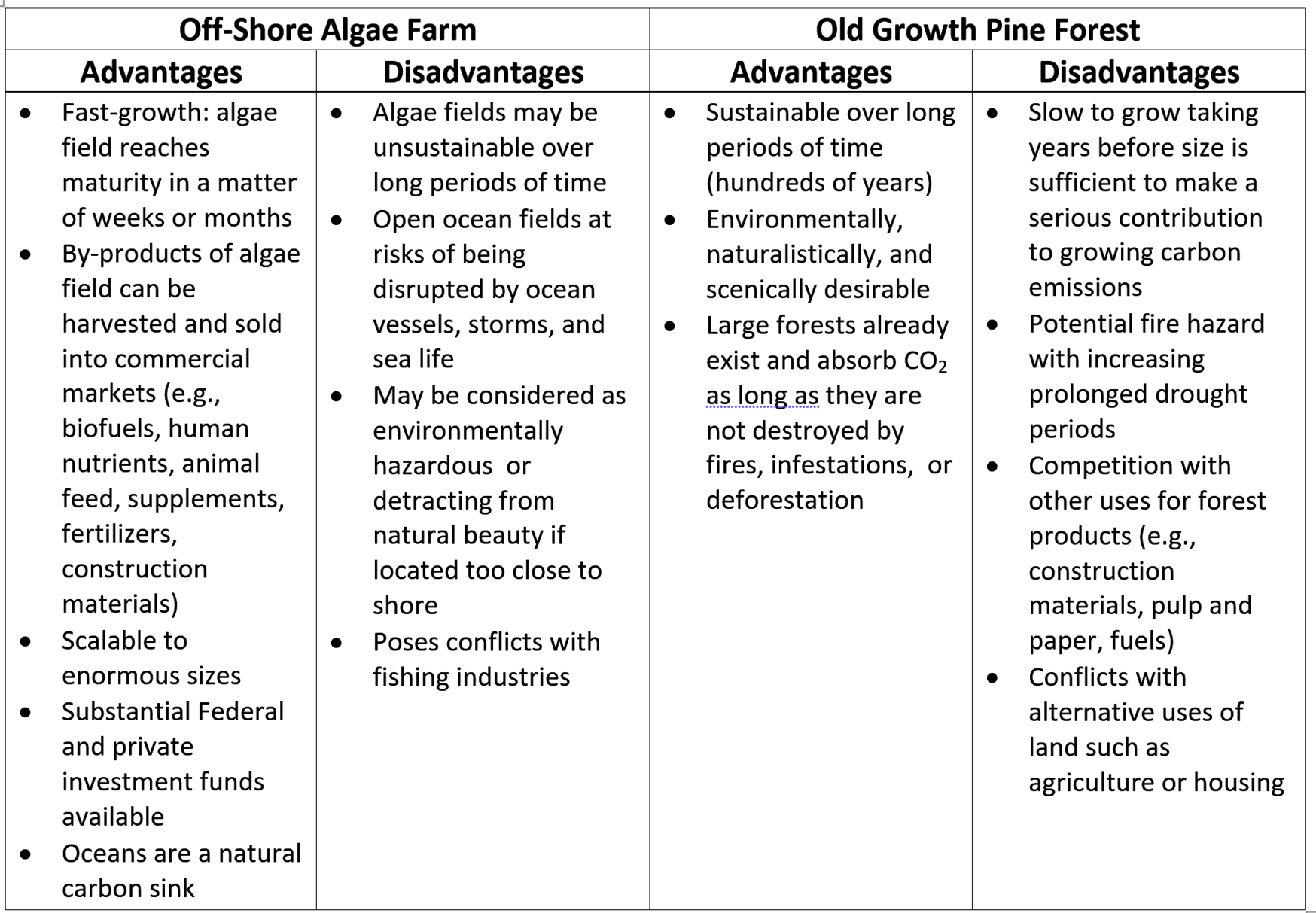Experiments
#6 ALGAE: CARBON DIOXIDE CAPTURE AND STORAGE
Middle School Version
Minerva Action Group: Gil Rodgers. Technical Advisor: Matt Huber, CEO, Algae Research and Supply, Inc., June, 2024 https://algaeresearchsupply.com/pages/about
This exercise is to help students become more knowledgeable and informed about the role that algae play in carbon dioxide capture and storage in our environment. This is done by conducting a hands-on experiment using Chlorella Vulgaris algae – a particularly fast-growing aquatic plant that can be easily and safely monitored in the classroom over several weeks. The exercise also addresses the potential for large, commercial scale, algae farms that not only capture significant quantities of CO2 from the atmosphere comparable to old-growth forests but also produce marketable by-products such as renewable biofuels; food, animal, and aquaculture feed products; fertilizers; textiles; and many other “green” products.
Did you know that algae can play an important role in absorbing and storing carbon dioxide (CO2) from the atmosphere just as trees, forests, and marshlands do? Today, projects are underway on a commercial scale called “algae farms” to help address climate change by capturing carbon dioxide and other greenhouse gases but also by producing commercial scale by-products such as fertilizers, animal food sources, fibers for construction products, supplements for human foods, and biofuels.
In this experiment, you will actually “watch” algae in action absorbing CO2 from your classroom, outdoors, or at home. On a macro perspective, you will also gain an understanding and appreciation of what this means in addressing climate change issues that we are well aware of today.
What are algae?
Algae is an informal definition of plant-like organisms that live in water. Algae are classified as photosynthetic organisms. These organisms come from different sources including bacteria, terrestrial plants, and ocean plants such as giant kelp. Algae thrive in nearly every habitat such as on the surfaces of ponds, lakes, streams, and oceans, and at the bottom of ponds, lakes, and oceans, on seaweeds and in marshes. They can attach to the floors of bodies of water, or they can be free floating such as plankton. Algae can occur as single cells, as colonies of identical cells, or they can be multi-cellular. Some plankton can even be mobile and move around using their flagella. Some of the common algae cultures with their Latin names are Chlorella Vulgaris (CV) (freshwater algae), Spirulina, and Nannochloropsis (seawater alga). Just try pronouncing these difficult names.
What are photosynthetic organisms?
Algae are nearly all photosynthetic organisms and therefore need light as the energy source to grow. Photosynthesis takes place in two stages: In the first, light is absorbed and used to synthesize energy molecules, with oxygen as a byproduct. These energy molecules are then used to power the second stage, in which carbon dioxide (CO2) from the air is fixed into carbohydrates such as glucose and sucrose, and oxygen (O2) is given off as a by-product. We can illustrate this as a simplified chemical formula:
The actual process is more complicated and involves molecules such as ATP (adenosine triphosphate) which actually stores energy from the sunlight. Because photosynthesis is such an ancient process — one that predates and, in fact, shaped our atmosphere’s current composition — it is not a particularly efficient one. But now it is a different story and plants are limited by the relatively small amount of carbon dioxide in the atmosphere and cannot efficiently lock it down. Luckily, photosynthetic algae have developed mechanisms that increase their efficiency by concentrating carbon dioxide around the enzyme responsible for fixing it into sugars. This biochemical boost is part of what allows algae to grow so quickly as you will see in the experiment. [i]
A more complete picture of the photosynthesis process in algae is shown in the picture below. With inputs of water, carbon dioxide, and energy from the sun, the algae produce biomass such as starch, bio-oils, and cellulose that can be made into commercial products. Oxygen is released as a byproduct to reenter the atmosphere or captured for other uses. [ii] Certain important nutrients are the “fertilizer” for the algae process, and example are nitrates (such as sodium nitrate), metals (such as iron or copper), and vitamins (such as thiamine).
Photosynthesis Process of Algae
Algae Growth Dynamics [iii]
What can we expect about the dynamics for how rapidly this process takes place? Chlorella vulgaris, for example, works very quickly within days and is therefore a good choice for this classroom exercise. The dynamic process can be more completely explained in five steps as illustrated in the picture below:
1. Lag or induction phase
2. Exponential growth phase: = Co e^mt, where ln C(t) = natural log of cell count at time t, C is the concentration of cells (number per mL), Co = concentration at t = 0, m = specific growth rate of species of algae, t = time (days)
3. Phase of declining relative growth rate
4. Stationary phase (optimal time for harvesting biomass)
5. Death phase when water quality and nutrients are depleted, and cell concentration decreases rapidly
For typical saltwater and freshwater algae, the entire growth cycle takes about 28 – 30 days (verify) as the nutrients are gradually used up. Therefore, algae fields must be re-fertilized with metals or other nutrients to provide the nutrients to sustain continual growth. [iv]
Graph Illustrating Phases for Algae Growth
Algae Classroom Experiment
The purpose of this experiment is for you to witness how algae captures CO2 from the atmosphere and converts it into biomass. We will use Chlorella Vulgaris (CV) algae which is very fast growing, and you will be able to see its progress by viewing the changes in the color of the water which correlates to the mass of cells. We will use small kits called “Beaker Bags” obtained from Algae Research and Supply, Inc. in Carlsbad, California to conduct the experiment [1].
Group the class into small teams of three to five students each.
In addition to the Beaker Bag kits, you will need the following materials for each team:
A clear glass or plastic container to hold the Beaker Bag upright
Bottled distilled or purified water without any chlorine or other chemicals and additives
A light source such as LED, incandescent bulb, or compact fluorescent light (CFL)
Space in a science classroom where you can leave the Beaker Bags for at least a week or two for the algae to grow
Please follow the instructions below for conducting the experiment. [v]
Record the density of cells (millions of cells per mL) in the following table using the attached graph for CV algae: The vertical axis is the depth of the Secchi Stick (DSS) in mm that you actually physically measure, and the solid black line shows the cell count on the “x” axis. As the depth ( DSS ) gets smaller and smaller the number of cells increases. The greater the number of cells in a fixed quantity of water shows that the density (cells/ML) is increasing. Hence, the dashed line shows increasing density in grams per liter (g/L) on the right “y” axis. The density is a measure of the amount of CO2 that has been absorbed by the algae growth process.
Summary of Observed Densities for Each Team
Discussion Questions
1. What are your overall conclusions about the dynamics of algae growth?
2. How do your experimental results compare with the time dynamics for algae growth shown in the graph above?
3. What other measurements might you use to show the relationship between algae growth and carbon sequestration?
How Could Algae Change Our World?
Algae plants can be used to sequester CO2 from the atmosphere just as trees and other living plants do on land. Algae has some advantages as it grows 10 times more rapidly than terrestrial plants and can be grown on non-productive and non-arable land as well as in the water. Through photosynthesis, algae capture CO2 and other greenhouse gases from the atmosphere and sequesters or stores it as carbohydrates (sugars and starches) or calcium carbonate. As you have seen in the experiment, photosynthesis requires just CO2 (or other GHGs such as NO2 and methane), light, nutrients, and water. In addition, however, the algae photosynthesis process produces useful byproducts that have commercial value which creates additional benefits beyond CO2 sequestration, such as renewable biofuels; food, animal, and aquaculture feed products; fertilizers; and other “green” products.
Some commercial scale operations on land are already underway such as Brilliant Planet [vi] and Planetary Technologies [viii].
Brilliant Planet [ix], located in London, UK, has received funding from Toyota and has built a 30,000 square meter (7.3 acres) production facility located in the coastal desert of Morocco.
Brilliant Planet Algae Farm on Mediterranean Seaside in Morocco
Planetary Technologies is on a mission to remove 1 billion metric tons of carbon dioxide from the atmosphere by 2035. [x] Planetary Technologies received a $1 million award from the Elon Musk Carbon Removal competition [xi].
Algae blooms in the oceans can be a major accelerator of this absorption by removing and storing copious quantities of CO2 to provide a significant means of reducing excessive GHG that is contributing to global climate change. Some estimates are that an acre of algae bioreactor in the sea can take out as much CO2 as an acre of trees. [xii] Let’s check this amazing assertion. To illustrate this in concrete terms, we analyze a hypothetical, but potentially real-world algae experiment of the future.
Student Thought Exercise
How much carbon dioxide would be captured by a hypothetical algae field in the ocean with a rim (circumference) of 100 kilometers (km)? How does this compare with a dense medium-growth pine forest in the Northeast of the same dimensions? Would this make a significant contribution to offsetting global emissions of CO2?
The calculations for making this comparison are tedious but fortunately have already been performed in an Excel Spreadsheet. Because there are many assumptions, and some are very preliminary “guesses,” there is a wide range of answers as summarized in the graph below.
On an identical surface area basis, the calculations show that the CV algae field may absorb comparable -- about 4,000 tons of CO2 per day -- to a dense, medium-growth pine wood forest consistent with other reports (e.g., endnote (i).) Using other assumptions an algae field may be able to absorb much more carbon dioxide than trees as has also been reported (e.g., endnote (i).)
Summarizing Results of CO2 Capture Calculations (CO2 Short Tons/Day)
To put this in context, however, the total world-wide emissions of CO2 from energy combustion and industrial processes in 2021 are expected to be 36 Giga MT (108 million t day-1 ) [xiii]. (See graph.) The sequestration of carbon dioxide from a huge algae field of this size, while certainly significant and making a big contribution, represents a tiny percentage of the annual global emissions. We need to do a great deal more to create a carbon neutral world.
Questions:
1. Where does the sequestered CO2 go? And can the carbohydrates be farmed and sold for commercial purposes?
2. How will algae farms keep refreshed and capturing CO2 on a continuing basis?
3. Will the proposed RIM algae field in the ocean be this productive over extended periods of time such as 150 or 160 years -- or even longer -- that are achieved by uncut old-growth forests?
4. Will ocean waves and transport vessels disrupt the algae field?
5. Please summarize the advantages and disadvantages of the two methods in the table below.
6. Class discussion of the advantages and disadvantages. Choose which one do you prefer or both? Which is more likely to be successful?
7. How would you give advice to state and federal agencies to actually implement your recommendations?
Thank you for conducting this experiment.
The Minerva Action Group
Gilrodgers1@gmail.com
Appendix
Example of Advantages and Disadvantages
Assumptions based on the following source documents:
Algae:
Carnie Science, What Can Plants Learn from Algae? April 27, 2022 https://carnegiescience.edu/news/what-can-plants-learn-algae
Green Algae Photosynthesis https://www.chegg.com/learn/biology/introduction-to-biology/green-algae-photosynthesis
What Percent of CO2 Is Absorbed by Algae? APRIL 30, 2022
https://www.shoyaatlanta.com/what-percent-of-CO2-is-absorbed-by-algae/
American Institute of Biological Science, Bioscience, Volume 60, Issue 9, October 2010, Pages 722–727, Microalgae: The Potential for Carbon Capture, https://academic.oup.com/bioscience/article/60/9/722/238034?login=false
Mature- and Old- Growth Pine Forests:
Robert Leverett, Susan Masino, and William Moomaw, Older Eastern White Pine Trees and Stands Accumulate Carbon for Many Decades and Maximize Cumulative Carbon Frontiers | Older Eastern White Pine Trees and Stands Accumulate Carbon for Many Decades and Maximize Cumulative Carbon | Forests and Global Change (frontiersin.org)
Forest Ecology and Management, Benchmark carbon stocks from old-growth forests in northern New England, USA, 1 December 2011, https://www.nrs.fs.fed.us/pubs/jrnl/2012/nrs_2012_hoover_001.pdf
Footnotes
[1] Beaker Bags will need to be purchased from Algae Research and Supply, Inc. algaeresearchsupply.com
End Notes
[i] Carnie Science, What Can Plants Learn from Algae? April 27, 2022 https://carnegiescience.edu/news/what-can-plants-learn-algae
[ii] Green Algae Photosynthesis https://www.chegg.com/learn/biology/introduction-to-biology/green-algae-photosynthesis
[iii] FAO, Manual on the Production and Use of Live Food for Aquaculture, Algal Production, https://www.fao.org/3/W3732E/w3732e06.htm
[iv] WHOI, Fertilizing the Ocean with Iron, November13, 2007, https://www.whoi.edu/oceanus/feature/fertilizing-the-ocean-with-iron/
[v] Algae Research and Supply, Inc., Algae Culturing Manual, 2011
[vi] Sequestering Carbon Through Algae Production: Our Investment in Brilliant Planet https://medium.com/toyota-ventures/sequestering-carbon-through-algae-production-our-investment-in-brilliant-planet-6e75883f1fe8
[viii] Carbon Removal Startup Planetary Technologies Announces $7.8M in Funding, Offer of 3,000 Carbon Credits, March 17, 2022 https://www.planetarytech.com/
[ix] Fortune, A U.K. startup is building the world’s largest algae farm that each year will capture CO2 equal to the emissions of 8,000 cars, July 5, 2022 https://fortune.com/2022/07/05/brilliant-planet-startup-marine-algae-carbon-capture-climate-change/
[x] https://www.planetarytech.com/
[xi] Associate Press, Algae is a Winner in Elon Musk-funded Greenhouse Gas Contest, April 22, 2022 https://abcnews.go.com/Technology/wihttps://abcnews.go.com/Technology/wireStory/algae-winner-elon-musk-funded-greenhouse-gas-contest-84242293
[xii] Boss Magazine, The Carbon-easters; Scaling algae for carbon capture and biofuels, 2020 https//the bossmagazine.com/algae-carbon-capture/
[xiii] IEA, Global Energy Review: CO2 Emissions in 2021, March 2022
https://www.iea.org/reports/global-energy-review-co2-emissions-in-2021-2



